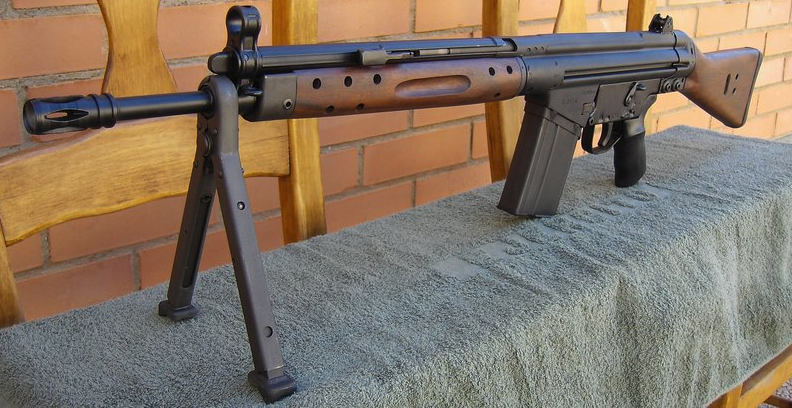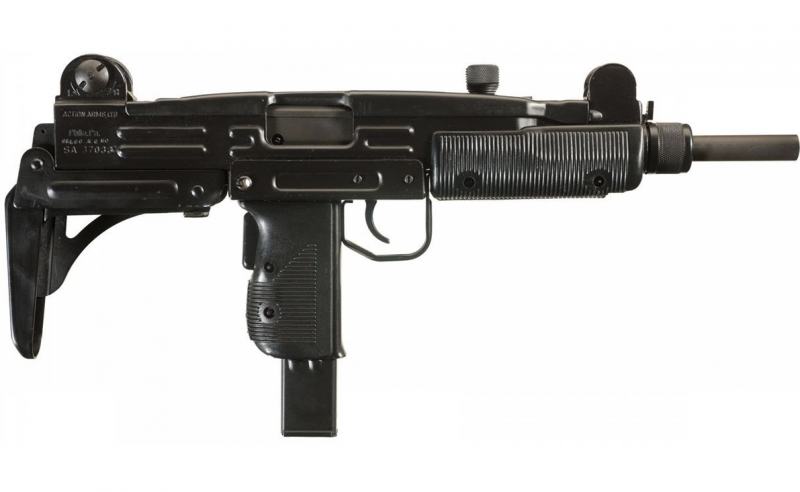History of: H&K MP5
Jeff Williamson 08.29.18

The Heckler & Koch Machinepistole 5, or H&K MP5 has a profile that is about as recognizable as the AK-47 or the M-16. Its characteristic snubby barrel and slender, curved magazine – after the first generation straight mags – has become a recognized image of a “submachinegun,” even more popular and potentially more recognizable than the Uzi.
Perhaps its widest debut to pop culture audiences was in the first PREDATOR movie in 1987 or DIE HARD 1988, but the gun was around for two decades before that. Today, not only does the gun’s look convey machinegun, it also has an association with fighting terrorists than few other guns possess. Further it helped put H&K into the public consciousness whereas before it was known only to military or law enforcement personnel.

Introduced in 1966, the MP5 was quickly snatched up by the German Federal Police for use of their special operations and tactics equivalents. Other nations also ordered for their anti-terror teams, but these were usually kept on the down-low: to admit their existence would be to admit the existence of terrorists and therefor give the bad guys the edge. It was a simpler time.
The gun’s first public international debut was in 1980 via live images of SAS commandos storming the Iranian embassy in London during Operation Nimrod. Submachine guns were already standard issue to law enforcement, but many, especially in the US, were left over surplus from the military. Here commandos were using the latest and greatest, and law enforcement agencies all over took note and pinched budget pennies to upgrade. H&K offered a new, ergonomic and modular design that was a direct descendent off of the company’s already proven G3 rifle system. The international market for the MP5 was closely linked to the rise in concern of international terrorism. This in turn created a market that a German arms maker needed to become successful.
Three former Mauser engineers: Alex Seidel, Edmund Heckler and Theodor Koch began H&K as a precision machine parts manufacturer in 1948 on the ruins of the Mauser factory in Oberndorf Germany. In the post war, French occupied sector, their product line was limited to tools, gauges, and precision parts for sewing machines. However, unlike the end of World War I where Germany was stripped of all but the minimum of military resources and saddled with debt, the Communist Menace of the Soviet Union demanded direct allied interaction which offered a window of opportunity for German arms makers.
In 1956 the West German government issued a tender for a new infantry rifle for the Federal Army: they settled on a German produced version of the Spanish CETME rifle – which was actually based on German designs from the end of World War II that had made their way from Germany through France to Spain in the previous decade. H&K won the tender and started mass producing the G3 in 1959.

Based on the success of that battle rifle H&K continued onward to make a rifle in 9mm, then ultimately 5.56NATO and the 7.62×39 Russian. Development on the 9mm began in 1964 and was quickly adopted two years later as the HK54. Political developments of the 1960’s and 70’s inspired many European security forces to explore new sub machinegun designs and the Beretta M12, the S&W M76 and the Uzi became common sights when SHTF. The HK54 was part of the pack. But it remained behind the scenes.

Already part of the German Federal Police force armory in 1972, the MP5 did not see action during the 1972 Munich Olympics Massacre. The Munich police force was like most other police agencies, using whatever they already had in their arsenals. What the Massacre did do was inspire other police agencies all over the world to prepare for a similar event. International forums were created and so were training courses and procedures. With that came a standardization in equipment to facilitate inter department logistics and cooperation.
Since the 1920’s submachineguns were already available to many police forces, but for much of the world, especially the US those guns were surplus from the military. In the 1960s and 70’s it was not unusual to see US LEO’s armed with Tommy guns and surplus M3 “grease guns.” The lack of standardization became apparent in the aftermath of Munich and arsenal directors began a search for something that was a worthy replacement.
H&K managed to get in on the ground floor with that: the MP5 offers benefits when compared to other smgs. It is compact, reliable and controllable. It is also relatively comfortable – even with the collapsible stock – and light. It offers high capacity on stable platform that fires a round that could be designed for limited penetration and reduced ricochet hazards. It came with an easy and efficient drum rear sight and modular forearms with options such as scopes and lights. It is easy to use even with winter gloves. What is more, in what appears typical of German guns, it is left handed friendly with ambidextrous selector switches and magazine release. The only favor to the right-handed world is the non-reciprocating cockling lever is placed on the left side of the weapon, so the right hand may remain in firing position. Finally, in the US where the traditional car carried weapon beyond the sidearm for law enforcement is a shotgun, the MP5 could be managed by smaller officers, and it took up less space with more ammo. After the Iranian embassy, if it was good for the SAS, it was good enough for anyone.
Throughout the 1980’s US SWAT teams started ordering different variants including silenced (SD) and ultra-compact (K). The adoption was discrete: only Special Weapons and Tactics typically had access to smgs, others would have them issued in cases of emergency and only if trained…. even if that training was a thirty second run down on what to press when. The MP5 is simple enough for that.
In the late 1990’s there was a change and it was a direct result of the North Hollywood Shootout on February 28, 1997. Two heavily armed bank robbers wearing body armor and on phenobarbital to calm their nerves, armed with thousands of rounds and illegally converted automatic rifles proved very difficult to take down with sidearms and smgs. The service 9mm, which was already dismissed by the FBI as a result of the Miami Shootout ten years before, was found to be inadequate against armored assailants. The result was a shift to M4 type rifles within the US LEO community. There was an attempt to offer the MP5 in 10mm and the .40S&W: calibers that were each adopted in turn by the FBI. However, the MP5 proved less reliable with these heavier calibers. In 1999, H&K offered the UMP in .40 and .45 acp, yet the MP5 remains in production.
M4s, while adequate, are large so, explorations into new weapons that fired the diminutive yet hypervelocity bullets like the 5.7×28 by FN and H&K’s 4.6×30 were explored. These rounds can defeat body armor, yet their systems are compact. They are also expensive. There were a lot of MP5s around, and in many situations, superior penetration is dangerous. Training for triple taps and the creation of more effective ammunition as an alternative keep MP5s in arsenals for special purpose situations, especially in the suppressed (SD) variant. They remain ideal in enclosed spaces such as busses or aircraft.
The 9mm is not going anywhere, though its tactical limitations are recognized even with improved modern ammunition. Even so, while budget constraints may keep the MP5 around, those who use it are not complaining.

